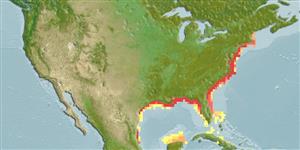Common names from other countries
>
Clupeiformes (Herrings) >
Dorosomatidae (Gizzard shads and sardinellas)
Etymology: Dorosoma: Greek, doris = lance + Greek, soma = body (Ref. 45335); cepedianum: Doro=lanceolate; soma=body (referring to the body shape of the young), and cepedianum, in honor of Bernard Germain Etienne de la Ville sur Ilion, Comte de La Cepede (1756-1825) (Ref. 79012).
More on author: Lesueur.
Environment: milieu / climate zone / depth range / distribution range
Ekologi
marina; sötvatten; brackvatten; anadrom (Ref. 51243); djupintervall 0 - 33 m (Ref. 39020). Subtropical; ? - 32°C (Ref. 12741); 49°N - 21°N, 108°W - 70°W (Ref. 188)
Northwest Atlantic: North America and Gulf of Mexico drainage (southeast South Dakota and central Minnesota, Great Lakes drainage, i.e. in Lake Erie, southern parts of Lakes Huron and Michigan, Lake Ontario basin; not Lake Superior; southernmost New York southward to the Mississippi system and to Gulf southward to Río Pánuco, Mexico.
Length at first maturity / Size / Vikt / Age
Maturity: Lm 36.1 range ? - ? cm
Max length : 57.0 cm FL hane/ej könsbestämd; (Ref. 40637); common length : 35.0 cm SL hane/ej könsbestämd; (Ref. 7251); publicerad maxvikt: 2.0 kg (Ref. 40637); rapporterad maxålder: 10 år (Ref. 72462)
Taggstrålar i ryggfenan (totalt) : 0; Mjukstrålar i ryggfenan (totalt) : 10 - 15; Taggstrålar i analfenan: 0; Mjukstrålar i analfenan: 25 - 36; Ryggkotor: 47 - 51. Body moderately deep; belly with 17 to 20 - 10 to 14 scutes. Mouth small; lower jaw short. Last dorsal fin ray long, about equal to distance from snout tip to mid-pectoral fin or beyond; anal fin long. Scales small, somewhat irregular. A dark spot behind gill opening. Gill rakers fine and numerous (Ref. 188). Branchiostegal rays 6 (Ref. 4639). Silvery to brassy, with a bluish back. Stomach thick-walled, gizzard-like (Ref. 7251).
Inhabits open water of medium to large rivers, lakes, and impoundments. Ascends creeks and small rivers with well-developed pools and enters brackish water (Ref. 86798). Occurs mainly in freshwater in large rivers, reservoirs, lakes, swamps, temporary floodwater pools, etc., but adults also found in brackish or saline water of estuaries or bays, preferring quieter open waters. Juveniles are found in great abundance well upstream from brackish water (Ref. 39041). Very young individuals apparently never enter brackish water (Ref. 38947). Larvae are most abundant in surface waters both day and night (Ref. 4639). A herbivorous filter-feeder almost entirely. Breed near the surface in freshwater from late winter (mid-March) through most of the summer (at least to about mid-August). The adhesive eggs sink. Used to some extent as fertilizer and cattle food (Ref. 188).
Temperature range for spawning: 10°C-28.9°C (Ref. 39042), usually most active above 18°C (Ref. 862, 3742).
Whitehead, P.J.P., 1985. FAO Species Catalogue. Vol. 7. Clupeoid fishes of the world (suborder Clupeoidei). An annotated and illustrated catalogue of the herrings, sardines, pilchards, sprats, shads, anchovies and wolf-herrings. FAO Fish. Synop. 125(7/1):1-303. Rome: FAO. (Ref. 188)
IUCN Red List Status (Ref. 130435)
CITES (Ref. 128078)
Not Evaluated
Threat to humans
Harmless
Human uses
Fiskeri: mindre kommeriell; sportfisk: ja; bete: usually
Verktyg
Special reports
Download XML
Internet-källor
Estimates based on models
Preferred temperature (Ref.
115969): 12.8 - 26.8, mean 24 (based on 244 cells).
Phylogenetic diversity index (Ref.
82804): PD
50 = 0.5312 [Uniqueness, from 0.5 = low to 2.0 = high].
Bayesian length-weight: a=0.00912 (0.00790 - 0.01053), b=3.04 (3.00 - 3.08), in cm Total Length, based on LWR estimates for this species (Ref.
93245).
Trofisk nivå (Ref.
69278): 2.4 ±0.21 se; based on food items.
Resiliens (Ref.
120179): Mellan, lägsta populationsfördubblingstid 1,4-4,4 år (tm=2; tmax=6).
Fishing Vulnerability (Ref.
59153): Low to moderate vulnerability (30 of 100).
Climate Vulnerability (Ref.
125649): Moderate to high vulnerability (49 of 100).
